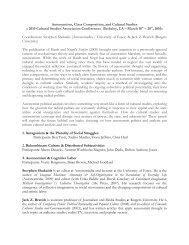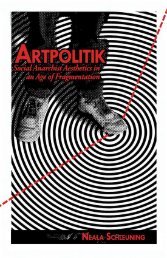nanopolitics handbook - Minor Compositions
nanopolitics handbook - Minor Compositions
nanopolitics handbook - Minor Compositions
You also want an ePaper? Increase the reach of your titles
YUMPU automatically turns print PDFs into web optimized ePapers that Google loves.
The timbres, intonations, paces and frequencies of voices underpin thecreation and expression of the affective and socio-political forces that mobilisethe utterance. Unlike many other theories of speech acts, Bakhtin posits thereceiver of the utterance as crucially engaged through her comprehensionand response-reaction to what is said. This active role of the listener is why,for Bakhtin, ‘the speech act is an action on the possible action of others thatstarts from the ethico-political dimension and the affective dimension of therelation with the other’. 23 This is seen as an agonistic position, as the utteranceoperates as a struggle between those participating in it, structuring the fieldof action of others.The spaces that produce, and are produced through, the utterance arepublic, as it happens in a field of relations with others. As we have seen, vocalinflections, as much as vocabularies, are imprinted with, and can intervenein, the circuits and flows of power in these public spaces. These dynamics ofdomination and cooperation, ‘modulate and influence...modes of expression’,that is to say the voice is deployed in complicity, sympathy, antagonism ordefiance. This echoes what Jean-Luc Nancy ascribes to listening and sound inthe formation of subjects and spaces, when he proposes that to listen is to enterthat spatiality by which, at the same time, I am penetrated, for it opens up in meas well as around me: it opens up inside me as well as outside and it is throughsuch a double, quadruple, or sextuple opening that a ‘self ’ can take place. 24Bakhtin understands voices and utterances as creating, unmakingand recreating worlds precisely because the composition of the utteranceoccurs through dialogue, it is event-based and simultaneously informed bythe conditions of both the speaker and the recipient. Utterances are deeplyinfused with social, political, cultural and economic histories and contexts.To think of the spaces and worlds that the soundings of voices make and aremade by, we must consider at least two planes, the spatial-material and therelational.On the material level it is useful to address what Barry Blesser and Linda-RuthSalter refer to as aural architectures: the ‘composite of numerous surfaces,objects and geometries’ 25 of a given environment. Sounds require spaceand air for their form, which means they ‘take shape on different scales ofspace’ just as they do different temporal scales. 26 This is how spaces manifestsound, even if the sound energy does not originate from the space itself; thisoccurs through reverberation and reflection – spaces, through their materialdensities and gaps, modulate and refract sounds and voices in peculiar ways.This occurs too on the level of bodies, the bodily cavity being an anatomicalacoustic chamber through which the sound of the voice is shaped. As BrandonLaBelle explains, sound sets into relief the properties of a given space, its244










